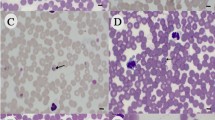Abstract
Fasciolosis, caused by the liver fluke Fasciola hepatica, is one of the most important parasitoses in cattle farming worldwide. In dairy cows, the trematode leads to economic losses due to decreased milk yield, a negative impact on reproduction parameters, and liver condemnations. In the present study, the seasonal patterns of F. hepatica antibodies in bulk-tank milk from dairy herds located in East Frisia, a region of the federal state Lower Saxony in the north of Germany, were investigated. This region was chosen since it is known as a high risk area for fluke infections due to its coastal location at the North Sea with the consequence of rather moist pastures. Between 669 and 868 bulk-tank milk samples were collected in January, September and November 2008 and 2010, respectively, and analysed for antibodies against F. hepatica with an in-house ELISA based on excretory–secretory antigens of the liver fluke. The overall East Frisian prevalence was 49.1%, 57.1% and 53.9% in January, September and November 2008 and 45.1%, 49.5% and 48.4% in 2010. From a number of 606 farms, which were sampled in all six investigated months, 34.5% of the farms continued to remain positive, whereas 30.9% continued to remain negative. A percentage of 69.1% (419 farms) were positive on at least one sampling occasion during the study period. The distributions of optical density ratio (ODR) values were skewed to the left but showed a second, lower peak in a high ODR range. Statistical analysis revealed a significant difference concerning the prevalence increase from January to September 2008. Furthermore, the prevalence decrease from September as well as November 2008 to these months in 2010 was significantly different, what might result from a more frequent use of anthelminthics or different climatic conditions.

Similar content being viewed by others
References
Bennema S, Vercruysse J, Claerebout E, Schnieder T, Strube C, Ducheyne E, Hendrickx G, Charlier J (2009) The use of bulk-tank milk ELISAs to assess the spatial distribution of Fasciola hepatica, Ostertagia ostertagi and Dictyocaulus viviparus in dairy cattle in Flanders (Belgium). Vet Parasitol 165:51–57
Berning H (2002) Vorkommen und Bedeutung der Rinderfasciolose in Nord-Niedersachsen anhand von Schlachtbefunden. Dissertation, Tierärztliche Hochschule Hannover
Bolln M, Zahner H, Bauer C (2007) Estimating the prevalence of Fasciola hepatica infection in dairy cow farms in Schleswig-Holstein, Germany. Abstract book of the 21st International Conference of the World Association for the Advancement of Veterinary Parasitology, p 425
Boray JC (1985) Flukes of domestic animals. In: Gaafar SM, Howard RE, Marsch REH (eds) Parasites, pests and predators. Elsevier, Amsterdam, pp 179–218
Cawdery MJ, Strickland KL, Conway A, Crowe PJ (1977) Production effects of liver fluke in cattle. I. The effects of infection on liveweight gain, feed intake and food conversion efficiency in beef cattle. Br Vet J 133:145–159
Charlier J, Duchateau L, Claerebout E, Williams D, Vercruysse J (2007) Associations between anti-Fasciola hepatica antibody levels in bulk-tank milk samples and production parameters in dairy herds. Prev Vet Med 78:57–66
Garcia HH, Moro PL, Schantz PM (2007) Zoonotic helminth infections of humans: echinococcosis, cysticercosis and fascioliasis. Curr Opin Infect Dis 20:489–494
Genicot B, Mouligneau F, Lekeux P (1991) Economic and production consequences of liver fluke disease in double-muscled fattening cattle. Zentralbl Veterinarmed B 38:203–208
Hardman EW, Jones RL, Davies AH (1970) Fascioliasis—a large outbreak. Br Vet J 3:502–505
Haroun ET, Hillyer GV (1986) Resistance to fascioliasis—a review. Vet Parasitol 20:63–93
Johnson EG (1991) Effects of liver flukes on feedlot performance. Agri-Practice 12:33
Kaplan RM (2001) Fasciola hepatica: a review of the economic impact in cattle and considerations for control. Vet Ther 2:40–50
Koch S (2005) Untersuchungen zur Verbreitung von Fasciola hepatica im bayerischen Milchviehbestand. Dissertation, Ludwig-Maximilians-Universität München
Kuerpick, B, Fiedor, C, von Samson-Himmelstjerna, G, Schnieder, T, Strube, C, (2012) Bulk milk-estimated seroprevalence of Fasciola hepatica in dairy herds and collecting of risk factor data in East Frisia, Northern Germany. Berl Munch Tierarztl Wochenschr (accepted)
Marley SE, Corwin RM, Hutcheson DP (1996) Effect of Fasciola hepatica on productivity of beef steers from pasture through feedlot. Agri-Practice 17:18–23
McCann CM, Baylis M, Williams DJ (2010) Seroprevalence and spatial distribution of Fasciola hepatica-infected dairy herds in England and Wales. Vet Rec 166:612–617
Mekroud A, Benakhla A, Vignoles P, Rondelaud D, Dreyfuss G (2004) Preliminary studies on the prevalences of natural fasciolosis in cattle, sheep, and the host snail (Galba truncatula) in north-eastern Algeria. Parasitol Res 92:502–505
Oakley GA, Owen B, Knapp NH (1979) Production effects of subclinical liver fluke infection in growing dairy heifers. Vet Rec 104:503–507
Randell WF, Bradley RE (1980) Effects of hexachlorethane on the milk yields of dairy cows in north Florida infected with Fasciola hepatica. Am J Vet Res 41:262–263
Ross JG (1970) The economics of Fasciola hepatica infections in cattle. Br Vet J 126:xiii–xv
Salimi-Bejestani MR, McGarry JW, Felstead S, Ortiz P, Akca A, Williams DJ (2005) Development of an antibody-detection ELISA for Fasciola hepatica and its evaluation against a commercially available test. Res Vet Sci 78:177–181
Schweizer G, Braun U, Deplazes P, Torgerson PR (2005) Estimating the financial losses due to bovine fasciolosis in Switzerland. Vet Rec 157:188–193
Vercruysse J, Claerebout E (2001) Treatment vs non-treatment of helminth infections in cattle: defining the threshold. Vet Parasitol 98:195–214
Acknowledgements
The authors want to thank the dairy Molkerei Rücker for providing bulk-tank milk samples and Novartis Animal Health for financial support.
Author information
Authors and Affiliations
Corresponding author
Rights and permissions
About this article
Cite this article
Kuerpick, B., Schnieder, T. & Strube, C. Seasonal pattern of Fasciola hepatica antibodies in dairy herds in Northern Germany. Parasitol Res 111, 1085–1092 (2012). https://doi.org/10.1007/s00436-012-2935-5
Received:
Accepted:
Published:
Issue Date:
DOI: https://doi.org/10.1007/s00436-012-2935-5




